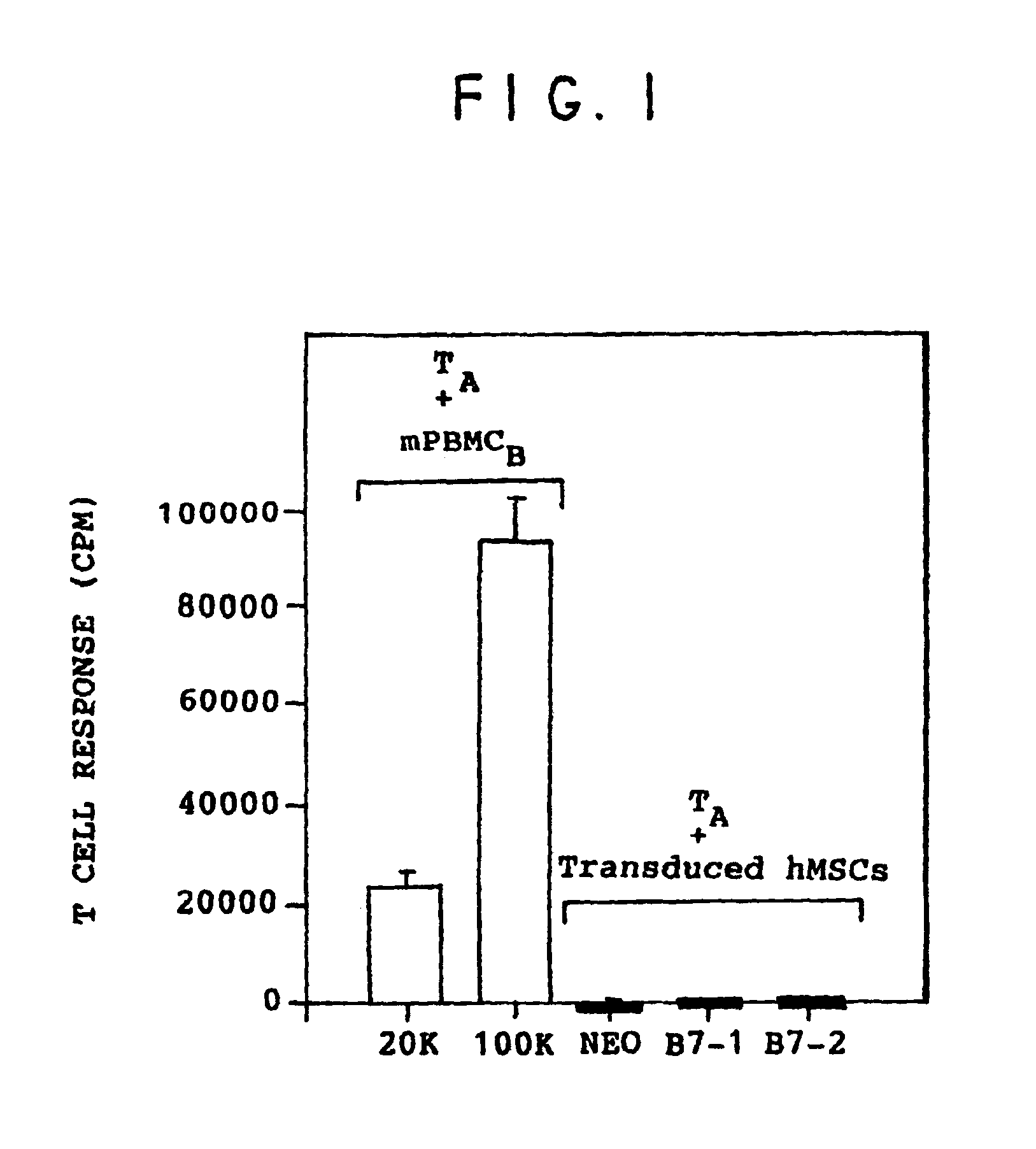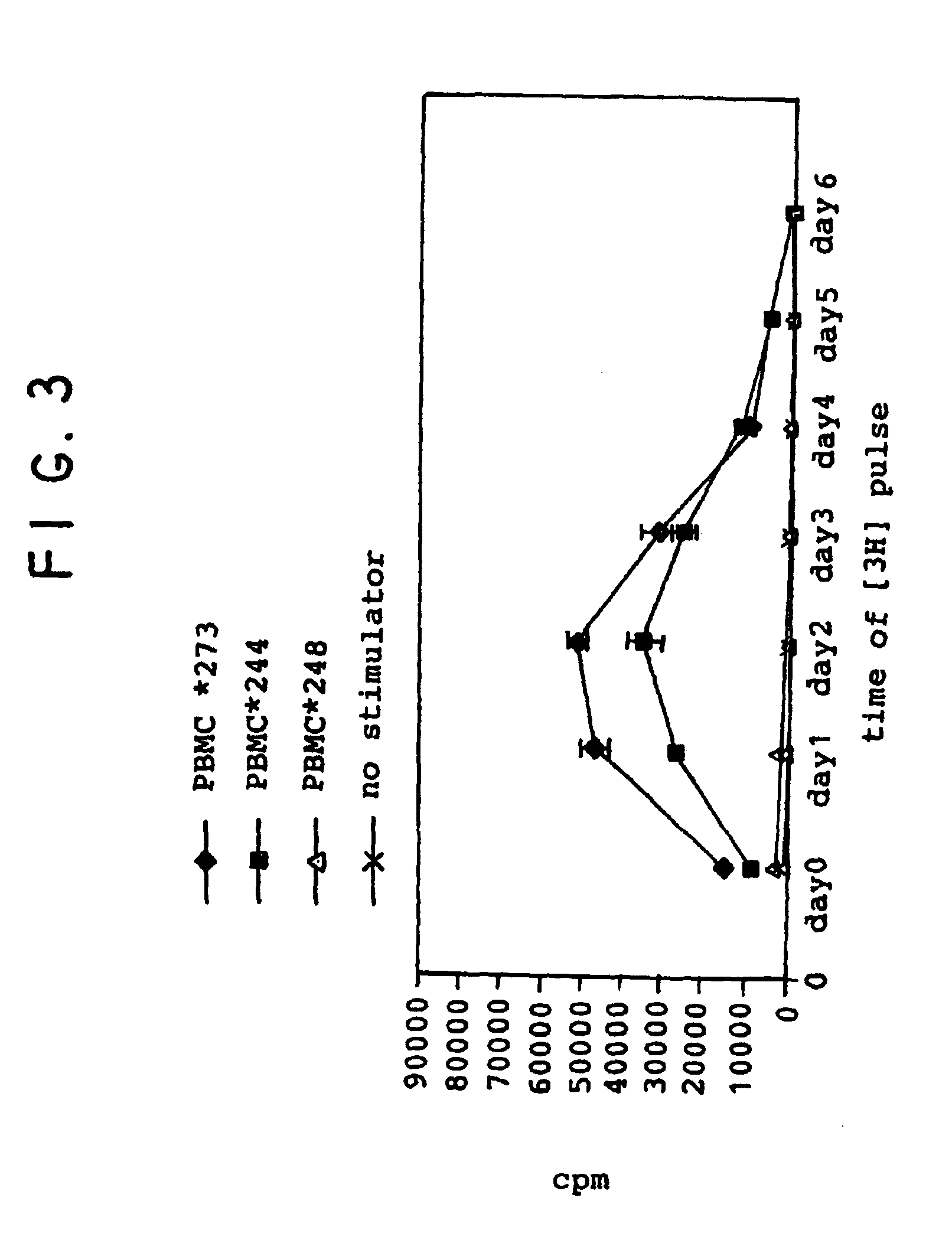Mesenchymal stem cells for prevention and treatment of immune responses in transplantation
- Summary
- Abstract
- Description
- Claims
- Application Information
AI Technical Summary
Benefits of technology
Problems solved by technology
Method used
Image
Examples
example 1
Absence of Alloreactivity of Mesenchymal Stem Cells
[0074]The mixed lymphocyte reaction measures the compatibility of the donor's surface antigens and is an indication of the likelihood of rejection of donor tissue. Cell surface antigens responsible for eliciting transplant rejection are class I and class II MHC antigens. T cells are alloreactive to foreign MHC antigens. Class I and II MHC molecules stimulate the mixed lymphocyte reaction.
[0075]Normal human volunteers were leukopheresed on a COBE SPECTRA™ apheresis system (COBE, Lakewood, Colo.). 1×105 T cells from individual A (TA) were cultured in flat bottom microtiter wells with mitomycin C treated allogeneic PBMCs (to prevent proliferation of PBMCs to T cells) from individual B (mPBMCB) for 7 days. The mPBMCBs were seeded at 20K and 100K. The cultures were pulsed with 3H-thymidine for the last 18 hours of the culture period to measure T cell proliferation. The results shown in FIG. 1 indicate that the TA cells recognized the PBM...
example 2
Suppression of Mixed Lymphocyte Reaction
[0079]To determine whether mesenchymal stem cells actively suppressed the allogeneic response, mixed lymphocyte reactions (MLR) were set up in tissue culture plates, with or without adherent mesenchymal stem cells obtained from 2 different donors: one donor matched the stimulator cells in the MLR and the other donor was unrelated to either the stimulator or responder cells.
[0080]105 PBMCs from individual A (PBMCA) were mixed with 105 target individual B's PBMC's (PBMCB). The PBMCBs were irradiated with 3000 rads X irradiation to prevent their proliferation due to activation by PBMCAs. Thus, only PBMCAs would proliferate. When PBMCAs and PBMCBs were mixed, a mixed lymphocyte reaction occurred wherein the PBMCA cells (responder cells) were activated by the surface antigens on the PBMCBs (stimulator cells). The cultures were incubated over an interval of 7 days and were pulsed with 3H-thymidine during the final 18 hours. In the presence of the PB...
example 3
Unresponsiveness in Secondary Mixed Lymphocyte Reaction
[0083]These experiments were performed to determine whether suppression of pre-activated T cells by MSCs resulted in specific unresponsiveness during secondary stimulation.
[0084]A. T cells from donor 248 (d 248) were primed by allogeneic PBMCs from donor 273 (d 273) for 7 days, then cultured for 3 additional days alone or in the presence of IFN-γ-treated MSCs from the same donor (d273). Cells were then re-stimulated by the same donor (d273), autologous (d248) or “third party” (d244) PBMCs.
[0085]Lymphocyte Preparation
[0086]Peripheral blood mononuclear cells (PBMC) were prepared by density gradient centrifugation on Ficoll-Paque (Pharmacia). Aliquots of cells were frozen in 90% FCS with 10% DMSO and stored in liquid nitrogen. After thawing, the cells were washed twice with MSC medium (DMEM with low glucose and 10% FCS) and re-suspended in assay medium (ISCOVE'S with 25 mM Hepes, 1 mM sodium pyruvate, 100 μM non-essential amino aci...
PUM
| Property | Measurement | Unit |
|---|---|---|
| Immunogenicity | aaaaa | aaaaa |
Abstract
Description
Claims
Application Information
 Login to View More
Login to View More - R&D
- Intellectual Property
- Life Sciences
- Materials
- Tech Scout
- Unparalleled Data Quality
- Higher Quality Content
- 60% Fewer Hallucinations
Browse by: Latest US Patents, China's latest patents, Technical Efficacy Thesaurus, Application Domain, Technology Topic, Popular Technical Reports.
© 2025 PatSnap. All rights reserved.Legal|Privacy policy|Modern Slavery Act Transparency Statement|Sitemap|About US| Contact US: help@patsnap.com



